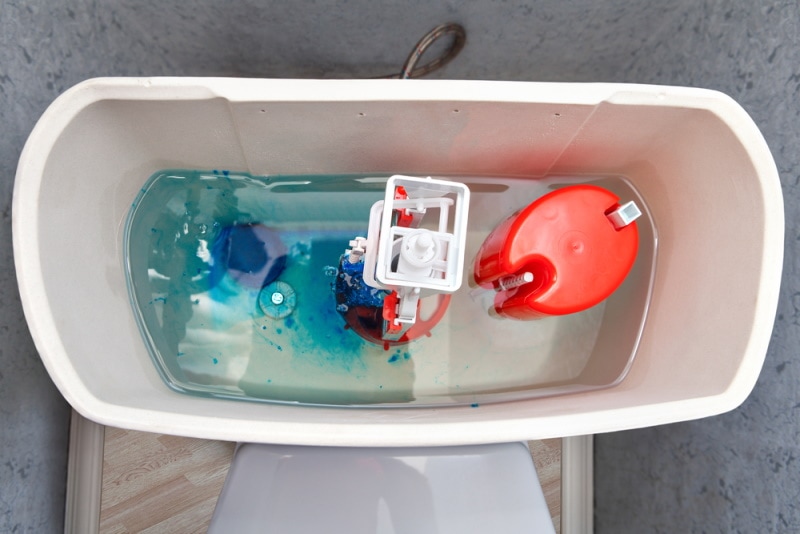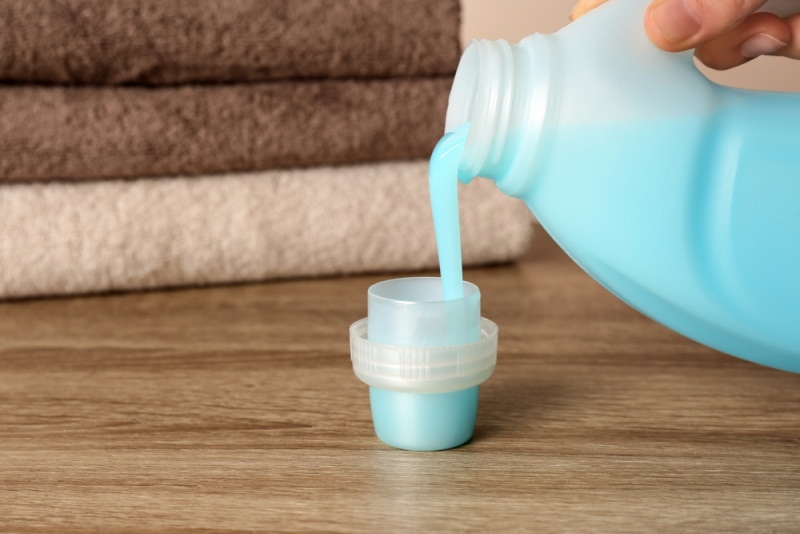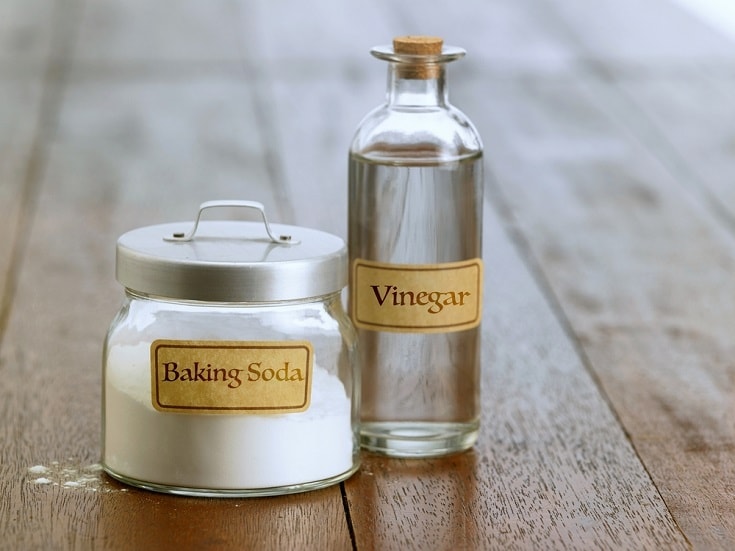Fabric Softener in the Toilet Tank: Great Idea or Dangerous Myth?
-
Pete Ortiz
- Last updated:

Toilets are the most challenging places in your house to keep clean for apparent reasons, and even when you’ve cleaned them, they may still smell grungy. You’ve probably tried many tricks and tips floating around online and on social media as the most incredible toilet cleaning hacks, one being pouring fabric softener in the toilet tank.
But besides ensuring that your loo has an attractive aroma after each flush, is fabric softener in the toilet tank a great idea or a dangerous myth? The simple answer is, it’s dangerous and should be avoided at all costs. Following the recommendations of cleaning detergent experts and sewage system professionals, let’s delve into this hack to separate the facts from fiction.
What Is Fabric Softener?
A liquid fabric softener or conditioner is added to clothes during rinsing or the rinse cycle of a washing machine to make the clothes feel soft and smell fresh. It’s a laundry substance made up of chemical compounds that coat the fabric with a water-resistant layer that also resists dryness and static.
Fabric softeners help prevent the crunch that garments get from air drying while reducing wrinkles to make clothes easier to iron.1 Besides the fragrances added to make your laundry smell nice, some of the ingredients in most commercial fabric conditioners include:
- Softening agents that belong to the quaternary ammonium compounds or cationic surfactants.
- Bluing agents give your clothes a bluish-white hue that appears brighter than hues of yellow.
- Smoothing additives from silicone make clothes less prone to wrinkling and easier to iron.
- Unlisted chemical components such as synthetic colorants and fragrances.
- Antimicrobial and whitening agents, although less frequent.

When added to the rinse cycle of your laundry, fabric softeners penetrate your clothes fibers to leave a softening film on natural and some synthetic fabrics. It’s not true softness when you use a conditioner, but an impression you feel due to the chemical layer’s coating.
These chemicals leave a sticky film on your clothes and washing machine, and this gunk will eventually clog its components. Researchers don’t recommend fabric softeners on sheets and towels, especially if you or a family member has sensitive skin or allergies. Over time, conditioners also make fabrics less absorbent, disrupting the natural makeup of fibers to age them faster.
Is It Safe to Pour Fabric Softener Into Your Toilet Tank?
Homemakers are going around on social media sites claiming that pouring a cup of fabric softener in your toilet tank will leave your bathroom smelling fresh around the clock. While there’s some truth in this myth, since it sounds easy and spreads fragrance with each flush, it’s a hack you should avoid at all costs.
Using fabric softener as a cleaner or fragrance in your toilet isn’t recommended as it’ll eventually lead to plumbing problems and isn’t safe for your septic tank. The slimy residual coating these conditioners leave in your pipes is worse than a smelly loo because they’re hydrophobic and not soluble in water.
Water in your toilet’s tank is cold, which makes it more difficult for the fabric softener compounds to break down, and fatty residue will stick to the tank’s surfaces and drain pipes. The buildup continues as you add more conditioner to ruin the mechanics of your toilet’s flushing system ultimately.
While most brands of fabric softeners contain a chemical called Sodium Lauryl Sulfate or SLS, its intended purpose is to break down oil and grease. That may sound like excellent news for your toilet tank, but there are several reasons why it’s not.
One is that it causes corrosion to your pipes and plumbing fixtures by eating away the outer protective layer, which leaves them vulnerable to rust and mineral deposit damage. SLS also tends to build up on the surface of your toilet tank, causing fixtures to clog and eventually leading to expensive repairs or replacements.
In addition, other reasons not to use fabric softener as a toilet tank refreshing trick include the following:
- Clogged Pipes
Using fabric softener to freshen up your toilet by pouring it into the water within the tank a few times isn’t damaging to your loo’s water closet. But continual use will spell trouble for your plumbing system, especially the pipes, in the long run.
Over time, the same chemicals that leave fabrics feeling filmy will clog toilet and sewerage pipe components since the softener components aren’t water soluble. That means the chemical makeup of these compounds has hydrophobic molecules besides palm oil and petroleum-based ingredients.
Slow draining is caused by a gel-like substance left behind by fabric softeners, which forms a type of cement when combined with water. It slows down draining or stops it altogether, leaving your toilet’s plumbing challenging and ineffective.

- Septic System Problems
Using fabric softener as a toilet tank water freshener isn’t a great idea if you have an onsite sewage treatment system or a septic tank. It’s one of the chemical-laden substances you should keep away from as it throws the system’s operation off balance.
Fabric softener dissolves the sludge that accumulates at the bottom of a septic tank, leading to a significant buildup of organic matter within the middle affluent layer. With proper treatment, the layers are dispersed into the earth or a septic field to be absorbed and act as fertilizer.
However, the additional sludge matter disrupts the absorption of the affluent layer and creates a barrier that interferes with your septic tank’s regular operation. Results are often early system failures and costs associated with pumping, repairs, or field sanitation.
- Harming Your Health and the Environment
Any chemicals you use in your home significantly affect the quality of your health and indoor air if that substance doesn’t biodegrade readily, like fabric softener. Whatever you flush down your toilet or sink eventually ends up in waterways, ultimately affecting the environment.
It’s best to avoid fabric softeners altogether, according to the U.S. Environmental Working Group, EWG, as it flags several ingredients in the compounds as harmful to health and the environment. These include the quaternary ammonium compound or ‘quats’ responsible for triggering asthma and adversely affecting the reproductive system.
There are also a lot of synthetic fragrances within fabric softeners for which the makeup chemicals are only sometimes listed. Still, galaxolide and phthalates are used in making these ‘scents.’ Anyone in your household who suffers from eczema, asthma, or allergies will be sensitive to these ingredients.
Similarly, preservatives and colorants are present in fabric softeners, as with other common household cleaners and products. Particularly, the EWG singles out colorants D&C violet 2 that’s linked to cancer, Glutaral and methylisothiazolinone, skin irritants toxic to aquatic life and which trigger asthma.
How Can You Prevent Foul Odors in Your Toilet Without Using Fabric Softener?

While problems with your toilet are common, some can prove challenging to find solutions for or fix. There are ways, however, to avoid the pervading smell of urine or mildew that regular household cleaners can’t mask.
Some tricks include cleaning your toilet or using baking soda and vinegar as your natural cleaning companion. There’s also a range of chemical-free cleaners that won’t harm your plumbing, health, or the environment.
You can end up with multiple problems from a toilet that’s not properly cleaned, not to mention odors and moldy growths. One way to ensure that your toilet’s always clean is to remove items and debris from your toilet bowl or tank while keeping the lid tight to prevent bugs and mice from entering.
An effective homemade cleaner consists of baking powder and white vinegar, readily available in your kitchen. For this mixture, use one part of the vinegar with two spoons of baking powder and add approximately three liquid ounces of water.
Use a spray bottle and shake before spraying on areas that require cleaning, especially if they’re stained or rusty, and leave to sit for five minutes. Take an old sponge or disused toothbrush and scrub your toilet bowl before rinsing with clean water and flushing the residue away.
Not only will baking soda and vinegar clean your toilet, but the mixture will also neutralize any odors without using chemical-rich fabric softeners or similar hacks. You can create more blends to pour into your toilet tank or within the bowl before you flush for excellent and fast results.
Conclusion
While putting fabric softener in the toilet tank is tempting, it’s not a great idea but a dangerous myth. Experts and sanitation professionals don’t recommend it due to the number of hydrophobic chemicals in many fragrant brands of fabric conditioners.
Not only are you risking clogging your toilet, but you’re also promoting rust and mineral buildup within your plumbing system. Fabric softener chemicals also throw your septic tank’s normal operation mode off balance and aren’t safe for your health or the environment.
If you can’t seem to get rid of foul odors from your loo, consider scented bath beads or some potpourri placed in a container on the tank.
- What Allergic Reactions or Triggers Are Caused By Contact with Fabric Softener Chemicals?
- Will Regular Use of Fabric Softeners Cause Plumbing Problems?
- Which Brands of Fabric Softener Contain Sodium Lauryl Sulfate or SLS?
- What’s the Risk to Humans and Animals from Continued Use of Fabric Softeners?
- https://www.accessdata.fda.gov/scripts
- https://archive.epa.gov/pesticides/reregistration/web/pdf/3092.pdf
Featured Image Credit: Grigvovan, Shutterstock
Contents



